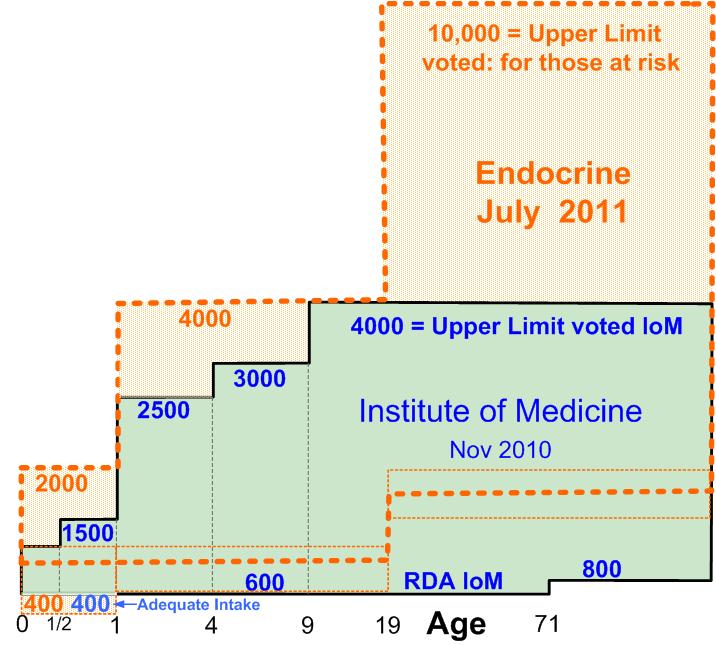Germans, Austrians, and Swiss declare that 800 IU and 20 ng vitamin D is enough
New Reference Values for Vitamin D.
Ann Nutr Metab. 2012 Jun 1;60(4):241-246.; Received: February 23, 2012; Accepted: February 23, 2012; Published online: June 1, 2012
German Nutrition Society Bonn, Germany (Deutsche Gesellschaft für Ernährung)
Godesberger Allee 18
DE–53175 Bonn (Germany) Tel. +48 228 3776 623, E-Mail strohm@dge.de
The Nutrition Societies in Germany, Austria and Switzerland edit the ‘Reference Values for Nutrient Intake’ together.
Currently, these reference values are under revision, whereby Vitamin D was the first nutrient to be revised.
In the recent past, many studies have been published on the association between vitamin D and bone health or the risk of various chronic diseases.
Thus, the D-A-CH reference values [D-A-CH arises from the initial letters of the common country identification for the countries
Germany (D),
Austria (A) and
Switzerland (CH)]
for the intake of vitamin D have been revised based on a critical review by the German Nutrition Society.
Both dietary intake and endogenous synthesis contribute to the body’s vitamin D status.
Since different factors modulate the extent of endogenous vitamin D formation, quantification is hardly possible.
Therefore, the new reference values for vitamin D intake are specified for a situation in which endogenous synthesis is completely missing.
Based on the findings of the critical review, serum 25-hydroxyvitamin D concentrations of 50 nmol/l or higher are considered an indicator of an optimal vitamin D status.
When endogenous synthesis is missing, adequate vitamin D intake is estimated as 20 µg per day for children, adolescents and adults .
Dietary vitamin D intake from habitual diet is not sufficient to achieve this value.
This gap has to be covered by endogenous vitamin D synthesis and/or additional intake of vitamin D.
It is clearly stated that the desired vitamin D supply can be achieved without using vitamin D supplements by frequent sun exposure.
200 IU ==> 800 IU beyond infancy
A good step in the right direction - a long ways to go, especially for those with dark skins
Wonder if they have considered infants, dark skin, overweight, pregnant, elderly, etc.
See also VitaminDWiki
90 % of Swiss men have less than 30 ng of vitamin D in the winter – Nov 2012
800 IU vitamin D resulted in 20 ng, 3200 IU resulted in 45 ng – RCT March 2012
930 IU of Vitamin D proposed for far North after review of literature review – Oct 2011
Four reasons why vitamin D levels should be higher than 30 ng – Aug 2011
Cadavers with good skeletons had 30 ng of vitamin D – Feb 2010
Low vitamin D levels even when taking 800 IU vitamin D – May 2011 Swiss
Recommend 100 IU of vitamin D per kg of infant weight – July 2011 Poland
744 IU vitamin D needed by Northern white teens to prevent Rickets – Jan 2011 Well, Germany probably has Rickets covered with 800 IU
800 IU vitamin D in milk did not improve bones of middle-aged adults – Jan 2011
Overview of Vitamin D Recommendations has the following chart

